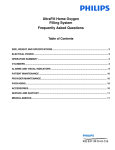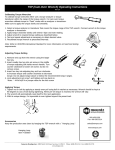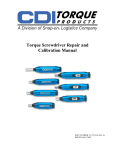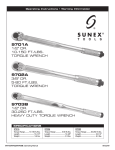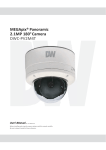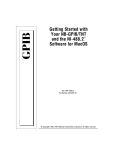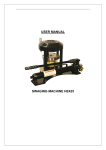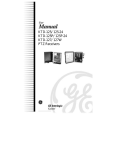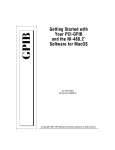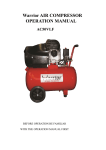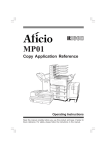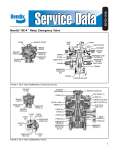Download IN1202-PI D, DX & DS User Manual.pub
Transcript
User Manual Features and Benefits Extremely Accurate Accurate within 2% of reading from 20% of full scale to full scale. Guaranteed against defect in workmanship and materials for one year from the date of delivery providing that they have been used according to instructions. Exclusive Torsion Bar Design This patented design features a connecting arm directly from the square drive to the easy-to-read dial. This enables the user to read the actual twist of the square drive. And, since a lever principle isn't used, hand-hold position is not critical, unlike the split or bending beam competitive torque wrenches. Compact Design and Tapered Nose This provides ease-ofoperation by allowing clearance where operating space is limited. Large Shock Resistant Dials Protected by dial "guards", the large easy-to-read dial numbers are set off against a contrasting color. With many increments on the scale, guess work is eliminated. Dial Pointers Work in either right or left-hand direction. The dial can also be rotated so the user can torque to zero from the desired value. Memory Needle Models Retain the highest torque reading for easy reference. For Quality Control testing, a Memory Needle Model displays the maximum reading obtained. This is excellent for verifying production torque applications. Indicator Light Models Indicates when a preset torque level is achieved. Set the dial to the required torque, and the light will go on when the proper torque is reached. This is particularly useful when the dial is not visible. Shock-Resistant Dial Mechanism Built to withstand rough usage, the mechanism which provides the expanded dial readings is shock protected with resilient and overload members. Consistent Readings The accuracy is not affected by the way it is held. Pull on the end of the handle or close to the dial and the reading remains the same. Handle extensions are furnished with many models which allow even greater flexibility. Compact The square drive is located at the very end of the torque wrench so that it can be used in areas where space is at a minimum. Friction-Free Operation A floating connecting beam between the torque measuring element and the dial mechanism has no bearing points and consequently there is no friction drag. This floating beam construction together with the precision of the dial mechanism renders the torque wrench practically friction-free. Accurate and Dependable All Precision Instrument D Torque wrench Series meets or exceeds all applicable requirements of: ANSI / ASME B107.14M, GGG-W-00686C, BS6073: 1988, ISO6789. TO GET ACCURATE TORQUE READINGS Your torque wrench is a precision instrument. Given proper care it will give many years of satisfactory use. For best results and accurate readings follow the instructions given below. 1. Set the dial of the Torque wrench by using method “A” or “B” explained below. Method A: 1) Turn the dial until the pointer is on zero. 2) Place the Torque wrench on the fastener. 3) Pull until the pointer reaches the torque required. Method B: 1) Turn the dial until the pointer is at the torque required. (On right hand threads set to the left of zero. On left hand threads set to the right of zero.) 2) Place the Torque wrench on the fastener. 3) Pull until the pointer reaches zero. 2. To make it easier to read the dial of all except the Memory Needle models, it is possible to place the pointer in any desired position. Turn the dial until the pin bears against the pointer. Then turn the dial 1/4 turn past the position desired. Finally, turn the dial in the other direction. The pointer will follow the pin back until it reaches the position desired. Then proceed with either Method “A” or “B,” as explained above. 3. To use the Indicator Light Model for clockwise applications, turn the dial until the gold pointer is set at the desired torque (the red pointer for counterclockwise applications). Place the Torque wrench on the fastener and pull until the light comes on. Check the bulb and battery if the light fails to light when the pointer touches the gold contact pin. 4. To use the Memory Needle Model in the clockwise direction, rotate knurled knob counter clockwise on top of crystal until Memory Needle contacts main pointer. Next turn the dial bezel counter clockwise until the Memory Needle is on zero. Place the Torque wrench on the fastener and pull on the wrench handle until the desired torque is reached. When the pressure is released the main pointer will return to zero and the Memory Needle will remain at the peak torque reached. For counter clockwise direction use, reverse above procedure. The Memory Needle feature can be used to record peak torque when the Torque wrench dial may not be visible. Be careful not to overtorque the fastener or Torque wrench. 5. Each time the Torque wrench is used, be sure that the dial and pointer are set correctly. 6. After each use of the Torque wrench make sure the pointer returns to zero or the pre-set value. If not, re-set the dial and pull again. 7. For an accurate reading, the final turn of the nut should be made with the Torque wrench. 8. The hub of the pointer contains a clutch which allows the stem to turn within the hub if a sudden impact occurs. This important safety factor protects the dial mechanism from shock damage. If a fastener suddenly breaks, it may change the pointer setting. Reset the dial and proceed as before. 9. Work on fasteners with clean and lubricated threads. 10. Your Torque wrench does not need lubrication. Do not attempt to oil it. TORQUE PRODUCTS FULL WARRANTY PRECISION INSTRUMENTS WARRANTS THAT PRECISION TORQUE PRODUCTS ARE FREE FROM DEFECTS IN WORKMANSHIP AND MATERIALS. Precision Instruments will repair or replace these tools which fail to give satisfactory service due to defective workmanship or materials. This warranty for Precision Instruments torque products is for ONE YEAR from the date of the original purchase. Repair or replacement shall be at the election and expense of Precision Instruments . Except where unreasonable, the product must be returned to Precision Instruments prepaid for warranty service. Precision Instruments does not provide any warranty for any product, or its calibration, subjected to abnormal use. Abnormal use includes misuse, modification, unreasonable use, neglect, lack of maintenance, lack of periodic calibration, or use after the tool is significantly worn. PRECISION INSTRUMENTS SHALL NOT BE LIABLE FOR ANY INCIDENTAL, SPECIAL OR CONSEQUENTIAL COSTS OR DAMAGES INCURRED BY THE PURCHASER OR OTHER including, without limitations, lost profits, revenues, anticipated sales, business opportunities, goodwill, or interruption of business and any other injury of damage. Some states do not allow the exclusion or limitation of incidental or consequential damages, so the above limitation or exclusion may not apply to you. This warranty is your exclusive remedy and is in place of all other rights and remedies. You may have other rights which vary from state to state or country. Precision Instruments, Inc. Warranty Information P. O. Box 1306 Des Plaines, IL 60017 Rev 01/03 IN1202-PI Printed in U.S.A. Why Measure Torque Modern consumer demand has forced industry to upgrade manufacturing efficiency. Because of this, manufacturers have expanded their production through special emphasis on such specifics as ‘‘increased power per cubic inch,’’ ‘‘power per dollar’’ and ‘‘product efficiency factor per pound.’’ In researching the need for increased product efficiency and the importance of complying with stringent safety standards, manufacturers found that the ‘‘nuts and bolts’’ principle needed special attention. Older products and machines were assembled using oversized parts having high safety factors and enormous strength. These assemblies required minimal attention, since nuts and bolts were much larger than necessary. In order to increase product efficiency per pound, smaller, more efficient machinery had to be produced using smaller yet stronger fasteners. Because of this, the ‘‘nuts and bolts’’ principles have new importance. Threaded Fasteners Threaded fasteners are used on all types of machinery, yet proper attention is often neglected. Improper torque can cause enough distortion to fracture castings, accelerate wear or cause running parts to seize. It is a known fact that a simple half-inch bolt may exert a force as high as 16,000 pounds-enough force to lift four or five automobiles. Quite obviously, threaded fasteners require special attention. Because of the importance nuts and bolts play in product efficiency, the Society of Automotive Engineers has established standards of minimum tensile strength for all major classes of threaded fasteners used by industry. Actually, the minimum tensile strength is only potential, considering practical usage. Because fasteners are used to hold assembly components together, stress caused by rapidly changing loads often complicates the fastener’s job. For example, under stress the investment in extra potential strength of an SAE grade five bolt is lost, and the quality of the entire machine lessened, if it is not properly tightened. Bolts not tightened properly may eventually loosen and fall out. Even bolts secured with a locking devise, may fail from fatigue. When a bolt is properly tightened, extra locking devices are unnecessary. For its cost, the heat treated SAE grade five bolt offers the greatest potential strength in standard production situations. But, to realize this potential, the bolt must be properly tightened. A Few Standard Precautions A few standard precautions will solve fastener problems. Since the fastener is usually the weakest link in any assembly, special attention is always necessary. This means that an incorrectly tightened fastener will fail before the machine itself fails. The job of determining proper bolt tightening. is simple. First, examine the bolt itself to determine its torque limits. Then check its maximum potential. Naturally, there are circumstances which will determine procedures and torque value for special situations but these are rare. Caution! Always consult manufacturers specifications when available. The most commonly used rule for determining proper torque for a fastener is to apply 70% of the torque necessary to cause failure. The ‘‘Production Torque Guide’’ chart in this manual indicates these values. Tightening to utilize the fastener’s potential strength is a necessary part of the fastener story, but it isn’t the whole story. Proper lubrication, washers, etc. are just as important as proper tightening, since as much as 80% of the torque applied to a fastener is lost through friction. When the relationship between torque and tension is out of control, reliability is out; therefore, proper lubrication is necessary to provide a constant clamping force over a series of applications. The best lubrication is a high stress type, such as ‘‘Never-Seez’’ Compound. On non-critical applications, seventy-two hour zinc phosphate and oil coating may be used. This is an inexpensive coating From lb.in. lb.in. lb.in. lb.in. lb.in. lb.in. lb.ft. lb.ft. N•m N•m N•m CONVERSION OF VARIOUS UNITS OF TORQUE Convert Convert To Multiply From To Multiply oz.in. 16 oz.in. lb.in. .0625 lb.ft. .08333 lb.ft. lb.in. 12 kg.cm. 1.1519 kg.cm. lb.in. .8681 kg.m. .011519 kg.m. lb.in. 86.81 N•m .133 N•m lb.in. 8.85 dN•m 1.13 dN•m lb.in. .885 kg.m. .1382 kg.m. lb.ft. 7.236 N•m 1.356 N•m lb.ft. .7376 dN•m 10 dN•m N•m .10 kg.cm. 10.2 kg.cm. N•m .09807 kg.m. .102 kg.m. N•m 9.807 and is furnished on many industrial fasteners direct from the manufacturer. Also, the surface under the head of the bolt or under the nut (whichever is the turned member) is important. Many manufacturers use hard flat washers with no spring effect. The hardness contributes to good correlation between the torque applied and the tension achieved. The unbroken circular flatness contributes to dimensional control and consistency of clamping force from bolt to bolt. Locking devices offer some protection against improper tightening. One of the latest trends is the use of nuts with physical disrupted threads to insure fastener locking. This type of device is manufactured by several companies, but should be examined for it’s own merits. (Remember, however, that galling can disrupt the torque-tension correlation when locking devices are used.) HOW TO COMPUTE TORQUE WHEN USlNG ADAPTORS If an adaptor or extension is attached to the square drive of a click-type torque wrench and this adds to its length, then the applied torque will be greater than the pre-set torque. A formula can be used to find what the preset-set torque should be in order to obtain the correct applied torque. Here is the formula: Dial Reading . Torque Wrench Pull Point x Torque Desired or = Pre-Set Torque . Torque Wrench Pull Point + Extension Length This becomes: RS = AxT when A+B RS = Dial reading or torque setting of the wrench. A = Distance from the center of the square drive of the torque wrench to the center of the handle grip pull point. B = Length of the adaptor from the center of the square drive to the center of the nut or bolt. Use only the length which is parallel to the handle. See figure 1 T = Torque desired. This is the actual torque applied to the fastener. Here is a typical problem: What should the setting be when ‘‘A’’ is 12’’, ‘‘B’’ is 6’’ and ‘‘T’’ is 30 Ib. ft. RS = AxT or A+B 12 x 30 12 + 6 or 360 or 20 pound foot 18 Therefore 30 pound foot of Torque will be applied at the fastener when ‘‘RS’’ is 20 pound foot. Note: If the torque wrench reads in pound foot, then ‘‘T’’ should also be in pound foot. ‘‘T’’ and ‘‘RS’’ should be in the same unit of measurement. ‘‘A’’ and ‘‘B’’ should also be the same unit of measurement. B A NO B A NO B A Figure 1 – Formula values for a Torque wrench THREADED FASTENER TENSION GUIDE ( Figures Represent Pounds of Clamping Force ) GENERAL TORQUE SPECIFICATION CHART FOR I.S.O.** METERIC FASTENERS*** ( when SAE 10 oil is used as a lubricant ) Minimum 40 50 60 80 100 120 Tensile kg/mm2 Strength P.S.I. 56900 71100 85340 113800 142200 170700 Proof kg/mm2 22.6 29.1 28.2 36.4 33.9 43.7 47.5 58.2 79.2 95 Load P.S.I. 32150 41390 40110 51770 48220 62160 67560 82780 112650 135130 Property Class 4.6 4.8 5.6 5.8 6.6 6.8 6.9 8.8 10.9 Stress Area 0.0091 Outside Diameter No.6 Threads Per Inch 32 Torque: 5 lb.in. 205 10 lb.in. 410 20 lb.in. 820 40 lb.in. 80 lb.in. 12.9 Figures are KILOGRAM METER except those that are bolded which are KILOGRAM CENTENETER Bolt Diameter Metric Inch 6 mm 0.236 49 63 61 79 74 95 103 126 172 206 119 153 148 191 178 230 250 306 417 500 8 mm 0.315 10 mm 0.394 235 303 294 379 353 455 495 606 8.2 10 12 mm 0.472 411 529 427 662 616 7.9 8.6 10.5 14 17 14 mm 0.551 654 8.4 8.2 10.5 10 12 13 17 23 27 16 mm 0.63 10 13 12 16 15 20 21 26 36 43 18 mm 0.709 14 18 17 23 21 27 30 36 49 59 22 mm 0.866 27 35 34 44 41 52 57 70 95 114 *** NOTE: Use only when manufacturers specifications are not available, these values are for stiff metal-to-metal joints and are based on 90% of proof load. DO NOT USE for gasket joints or joints of soft materials ** I.S.O.= International Standardization Organization. If Your Torque Wrench Needs Repair 1. Send it to an authorized Precision Instruments Service Center, or give it to your Precision Sales representative. Do not attempt to repair it yourself. 2. If the warranty is no longer in effect, your Precision Instruments Customer Service Representative will contact you with repair charges for your approval before being repaired. 3. A series of testers are available from Precision Sales for checking the accuracy of your Torque Wrench. See your Precision Sales representative for more information. 0.0524 5/16" 18 337 674 1348 541 1082 2043 4092 1625 3250 6503 0.0775 3/8" 16 0.1063 7/16" 14 0.1419 1/2" 13 0.1819 9/16" 12 0.226 5/8" 11 0.3344 3/4" 10 0.4617 7/8" 9 1224 2448 4896 9796 2143 4286 8572 3899 7799 7065 9749 12186 14623 17061 19498 24373 0.6057 1" 8 0.7632 1-1/8" 7 0.9691 1-1/4" 7 8832 11049 13261 15462 7915 9894 11872 13851 12117 17664 22100 26523 15830 19788 23745 31660 39576 12245 10716 13395 16091 500 lb.ft. 750 lb.ft. 1,000 lb.ft. 1,500 lb.ft. 13836 17296 20776 27700 12113 15142 18170 24227 11985 14382 19176 13247 17663 34592 51941 30284 45426 60569 23971 35956 47942 71985 2,000 lb.ft. 3,000 lb.ft. 5,000 lb.ft. 10,000 lb.ft. 20,000 lb.ft. Visit us at: www.torqwrench.com 1.4052 1-1/2" 6 1.8993 1-3/4" 5 2.8917 2" 12 4.5951 2-1/2" 12 22079 33118 44158 66237 19754 29631 39508 59262 22678 30238 45358 31724 47587 36289 88317 79017 118525 197543 60477 90716 151193 302387 63449 95174 158624 317248 987 1482 2964 5928 11857 200 lb.ft. 250 lb.ft. 300 lb.ft. 400 lb.ft. In some cases it may be desirable to know the total clamping force obtained for a given torque. Values are approximate. SAE 30 engine oil was used as lubricant. Use of high stress lube may increase value 20% or more. Highest values for a given size may only be obtained with heat treated bolts having minimum tensile strengths of 150,000 P.S.I. or more. Caution GENERAL TORQUE SPECIFICATION CHART FOR I.F.I.* METRIC FASTENERS** ( when SAE10 oil is used as a lubricant ) Minimum Tensile *** 400 420 520 830 900 1040 1220 Strength Mpa Proff Load MPa 225 310 380 600 650 830 970 Property Class 4.6 4.8 5.8 8.8 9.8 10.9 12.9 Bolt Diameter Torque: Newton Metre metric inch 5mm 0.197 2.9 4 5 8 11 12 6mm 0.236 5 7 8 14 18 21 7mm 0.276 8 11 14 24 30 35 8mm 0.315 12 16 20 34 44 50 10mm 0.394 23 32 40 70 85 100 12mm 0.472 40 56 70 120 150 180 14mm 0.551 65 90 110 190 240 280 16mm 0.63 100 140 170 270 290 380 440 20mm 0.787 200 330 520 740 860 24mm 0.945 340 580 920 1260 1480 30mm 1.181 680 1820 2520 2940 *** Megapascal ** Note: Use only when manufacturers specifications are not available, these values are for stiff metal-to-metal joints and are based on 90% of proof load. DO NOT USE for gaskets joints or joints of soft materials. * I.F.I. = Industrial fasteners Institute. 315 630 1264 0.0318 1/4" 20 100 lb.ft. 125 lb.ft. 150 lb.ft. 175 lb.ft. E-mail us at: [email protected] Fastener 0.0175 No.10 24 10 lb.ft. 20 lb.ft. 40 lb.ft. 80 lb.ft. Precision Instruments, Inc. Sales (toll free): 866-TWRENCH 1846 Miner Street (866-897-3624) P.O. Box 1367 Des Plaines, IL. 60017 Fax: 847-824-7629 Always use manufacturers specifications when available. These specifications are approximate and may not be appropriate for some applications. No liability is assumed for errors which may result from the use of any of these specifications. 0.0141 No.8 32 157 316 632 1264 48386 72579 120966 241932 483864 * Stress area is calculated as the area of the circle whose diameter is the mean between the root and pitch diameters. This closely approximates the actual stress condition. Maximum theoretical clamping force cannot be obtained from threaded fasteners. Additional stresses to the fastener are caused by the torsional forces of tightening. PRODUCTION TORQUE GUIDE Body size of Outside Diameter 1/4 5/16 3/8 7/16 1/2 9/16 5/8 3/4 7/8 1 1-1/8 1-1/4 1-3/8 1-1/2 1-5/8 1-3/4 1-7/8 Type Minimum Tensile Strength Material S.A.E 2 Steel 74000 P.S.I Low Carbon 6 12 20 32 47 S.A.E. 5 Steel 120000 P.S.I Medium Carbon Heat Treat 10 19 33 54 78 114 154 257 382 587 794 S.A.E. 7 Steel 133000 P.S.I. Medium Carbon Alloy 13 25 44 71 110 154 215 360 570 840 1325 1825 2500 3000 4000 5300 7000 7500 11000 15500 21000 27000 S.A.E. 8 Steel 150000 P.S.I. Medium Carbon Alloy 14 29 47 78 119 169 230 380 600 900 1430 1975 2650 3200 4400 5650 7600 8200 12000 17000 23000 29000 16 33 54 84 125 180 250 400 640 970 1520 2130 2850 3450 4700 6100 8200 8800 13000 18000 24000 31000 Socket Head Cap Screw Socket Set Screw Machine Screw Stainless Machine Screw Stainless Machine Screw Yellow Brass Silicone Bronze Type "B" Machine Screw Aluminum Machine Screw Monel Sems Heat Treated Steel Studs Tapping Screw 160000 P.S.I. 212000 P.S.I. 60000 P.S.I. 2 3 4 5 High Carbon Quenched Tempered High Carbon Quenched Tempered 6 9* 8 10 69 96 155 206 310 480 16* 30* 70* 140* 18 29 43 63 100 146 675 900 2.6* 4* 5.5* 8* 10* 20* 23* 75* 132* 20 31 43 58 95 130 194 260 400 500 725 316 2.7* 4* 5.7* 8* 10* 22* 25* 80* 140* 22 34 46 60 100 135 210 280 425 515 750 16* 20* 65* 110* 17 27 37 49 78 104 160 215 325 400 595 2* 3.3* 4.4* 6.4* 8* 70000 P.S.I. CU 96 ZNI-5 Min. 2.3* 3.7* 4.9* 7.2* 10* 19* 22* 70* 125* 20 30 41 53 88 117 180 250 365 450 655 55000 P.S.I. CU 3.8-4.9 1.2-1.8 MN .3-.9 1.4* 2.1* 2.9* 4.3* 5.4* 12* 15* 46* 82* 13 20 27 36 62 83 128 170 255 315 460 11* 21* 27* 87* 155* 23 36 50 67 115 155 235 315 475 585 850 82000 P.S.I. 120000 P.S.I. NI 67 CU 30 FE 1.4 2.5* 4* 5.5* 8* 1018 1022 4* 5* 7* 2-1/4 2-1/2 2-3/4 3 9500 1105 1500 1775 2425 3150 4200 4550 6550 7175 13000 16000 18-8 CU 63 ZN 37 2 1100 1470 1900 2360 2750 3450 4400 7350 11* 15* 27* 37* 90* 200* 330* Use SAE 2.5 and 8 values when grade is known, with nut of sufficient strength. Set up joint as it will be in production use 70% of over-torque failure as production specifications. All figures are POUND FEET except those marked with an ASTERISK ( * ) WHICH ARE pound inches. These values are for lubricated fasteners. Zeroing the Precision Instruments D-Line Dial-Type Torque Wrench Zeroing the Precision Instruments D-Line Dial-Type Torque Wrench Zeroing the Precision Instruments D-Line Dial-Type Torque Wrench Zeroing the Precision Instruments D-Line Dial-Type Torque Wrench The wrench is shipped with the main pointer lined up on the zero mark and pointing straight forward. The wrench is shipped with the main pointer lined up on the zero mark and pointing straight forward. The wrench is shipped with the main pointer lined up on the zero mark and pointing straight forward. The wrench is shipped with the main pointer lined up on the zero mark and pointing straight forward. If the main pointer ever comes to rest at an angle other than straight forward, hold the outer dial ring with your index finer and thumb… If the main pointer ever comes to rest at an angle other than straight forward, hold the outer dial ring with your index finer and thumb… If the main pointer ever comes to rest at an angle other than straight forward, hold the outer dial ring with your index finer and thumb… If the main pointer ever comes to rest at an angle other than straight forward, hold the outer dial ring with your index finer and thumb… And turn the outer dial ring to line up the main pointer with the zero mark. Note: This will not affect the calibration of the tool. And turn the outer dial ring to line up the main pointer with the zero mark. Note: This will not affect the calibration of the tool. And turn the outer dial ring to line up the main pointer with the zero mark. Note: This will not affect the calibration of the tool. And turn the outer dial ring to line up the main pointer with the zero mark. Note: This will not affect the calibration of the tool. IN1247 10/07 IN1247 10/07 IN1247 10/07 IN1247 10/07




